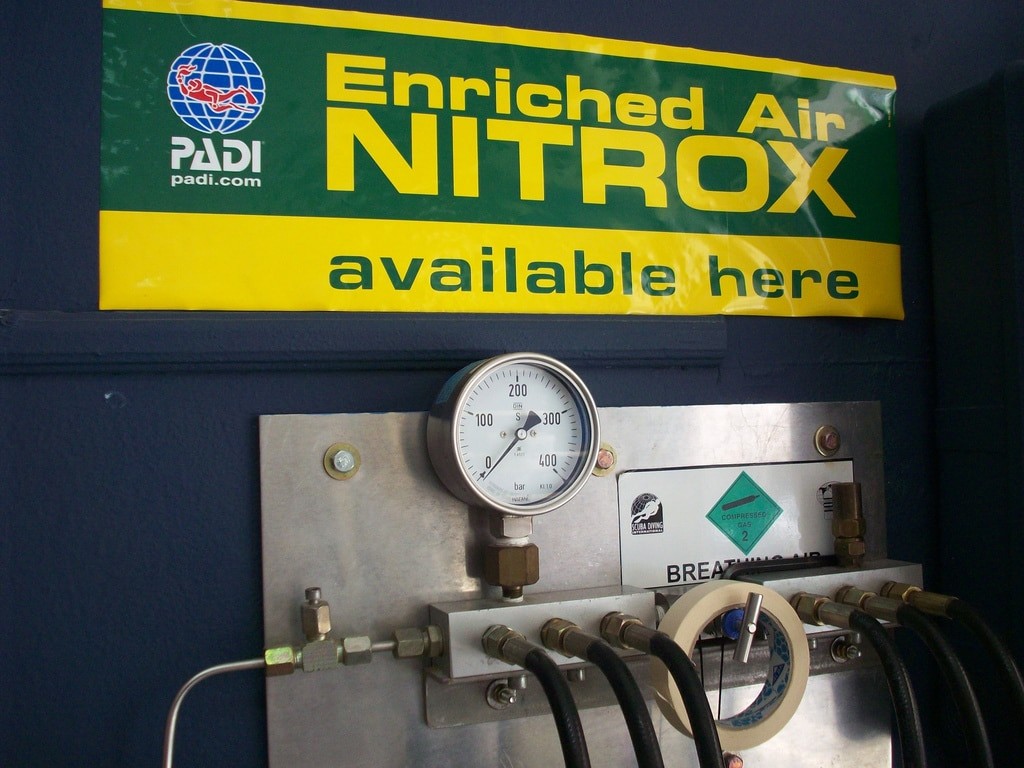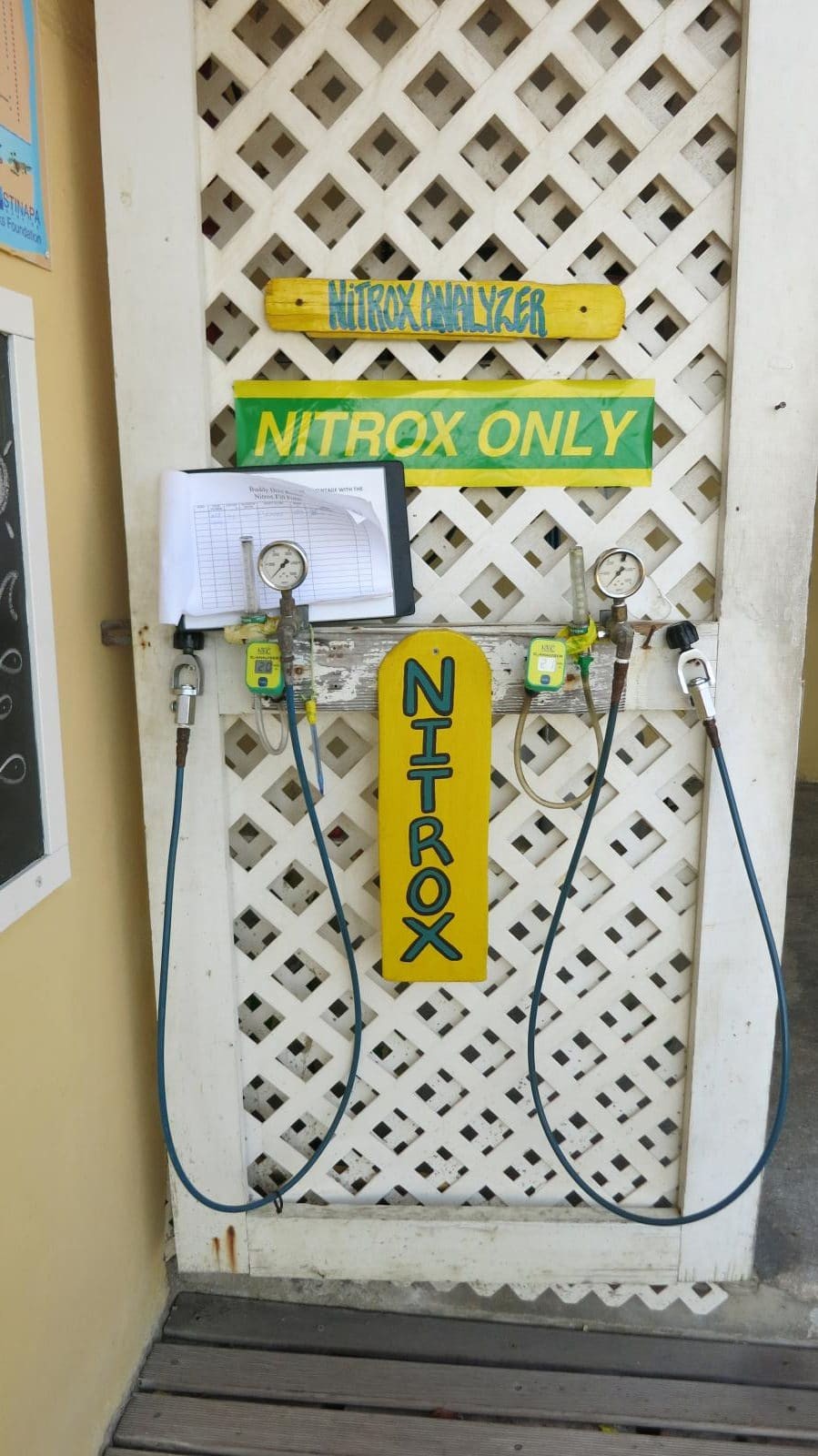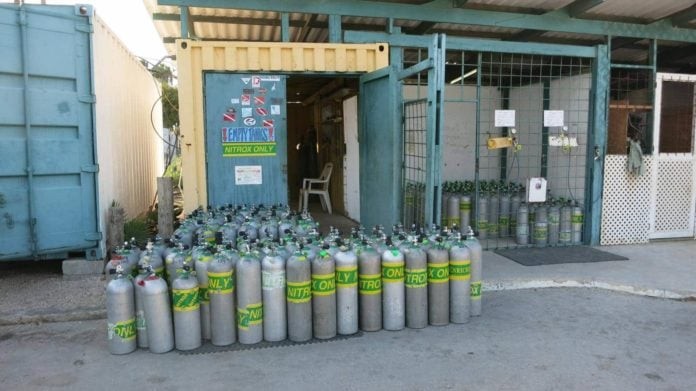Nitrox or more precious Enriched Air Nitrox or EAN has been available to recreational divers for over two decades. Still, it is not understood by many divers. In fact, one training agency called it Safe Air. EAN does have its benefits but it also has its risk so the term Safe Air is misleading. Let’s get some basic concepts and terms down before diving into the pros and cons of EAN.
Enriched Air Nitrox is created by adding additional oxygen to the compressed air filling your scuba tank. The air that surrounds us is approximately 78% nitrogen and 21% oxygen. By adding oxygen we change that ratio. In scuba diving, we identify the percentage of oxygen in our cylinders. If the cylinder has 32% oxygen we refer to it as EAN32.

The Rewards of Using Nitrox
That raises the question, what good does that do you. Honestly the extra oxygen does little for you. It is the decrease in nitrogen that is the key to the success of EAN. Using Enriched Air Nitrox has one of the following benefits:
- It extends your bottom time for a specific depth or
- It decreases your risk for a specific depth.
As you know, when we dive the increase pressure impacts on the amount of gases in our bloodstream and into our tissues. The pressure allows more nitrogen to enter our bodies. As we return to the surface that nitrogen needs to leave our body. Having too much nitrogen in our system can cause Decompression illness. Scientific studies have determine how long we can stay at a certain depth and be able to ascend directly to the surface arriving with the nitrogen level in our system at an acceptable level. This is referred to as the the No Decompression Limit or NDL. If we go beyond our NDL, then we must make decompression stops on the way to the surface.
The benefit of using EAN at depths is there is less nitrogen available to be forced into our tissue that would need to be removed to surface safety. Lets look at what this means with some examples. Imagine a great dive to 25 meters using your standard air. At around 29 minutes you would reach your NDL. If you was using EAN32 (32% oxygen) we can stay for 37 minutes, that over 20% more bottom time. If I use EAN38 (38% oxygen), our NDL extends to 56 minutes. In this example using EAN38 and possibly also with EAN32, we have shifted our limiting factor from NDL to air supply. In a situation where the air supply becomes the controlling factor we have less nitrogen in our system then the NDL would have let us absorbed. This will slightly reduce our risk. Many divers will use Nitrox but maintain the air NDL or set their computers for air to create larger margin of safety.
You will often hear people say that with Nitrox you can go deeper. That is not a 100% true statement, in fact it could be 100% deadly. Using air at 25 meters our NDL is 29 minutes. However, using EAN32 we can dive to 33 meters before having a 29 minute NDL. So it could be looked at that you can dive deeper if you are just comparing depth and a set NDL. There is a limit, that we will discuss shortly.
The Risk of EAN
One of the things that irritates me when I am reading a news article about scuba diving is when the reported calls our scuba tanks oxygen tanks. Except for very limited use in technical diving and as a first aid measure on the surface, we do not use pure oxygen. A very simple reason it can kill us. At a high partial pressure oxygen (ppO2) becomes toxic, causing our bodies to go into convulsions and shutting down our organs. When our body will react is different for each person but having a ppO2 of 2.0 is considered lethal. Recreational divers are trained never to exceed a ppO2 of 1.6 and to plan your dive using a ppO2 of 1.4. the NDL times used in the examples above were using the 1.4 limit. If we were to dive with 100% oxygen at ten meters the ppO2 would be at 2.0. Our maximum depth using 100% oxygen and staying within the 1.4ppO2 recommendation would be 4 meters.
When we plan our dive with air we concern ourselves with our nitrogen intake expressed as NDL and how long the air will last. The ppO2 does not come into play because we will not reach the 1.4 ppO2 until we are past 56 meters. Our NDL and air supply will not let us go that deep with single tank and return to the surface. However, if we were to go on a deep dive to 40 meters the limit of recreational diving, air would give us 9 minutes and for most divers the NDL would be the controlling factor of the dive. Using EAN38 at that depth would give us a 1.90 ppO2, well above the safety limit for recreational divers and possibly lethal for many divers. Even using EAN32 would put us above the planning limit and right at the safety limit.

It is these issues that make it necessary to be trained as a EAN diver. EAN divers are responsible for verifying the oxygen content of their cylinder before each dive. Cylinders containing Nitrox must be marked. Using a meter, they check the oxygen content, they calculate their Maximum Operating Depth or MOD and record both on a log. They also mark a sticker on the tank with the MOD and oxygen percentage. The MOD tells the diver how deep they can go before reaching the 1.40 ppO2 limit.
Get Trained as Nitrox Diver.
Nitrox has no benefit to offset the additional cost if you are diving at 30 feet or shallower. The air supply will give out long before the NDL time is reached. Beyond that depth you can start seeing a shift where the NDL becomes the controlling factor. Being in a position where you can choose to increase your time gives you more options. There are even a few liveaboard vessels that require divers to use EAN. The training for EAN is short, there is a knowledge segment which explains the descriptions I gave here in more details and show you how to analysis your gas supply. It requires just two open water dives. Many dive schools will combine open water training or advance open water training with a EAN diver course requiring just one extra dive.
There is one other thing about using Nitrox. Many divers say they are more refreshed after diving Nitrox, more energy and not tired. Scientific studies say there is no proof that Nitrox boast your energy level or reduce your fatigue.

